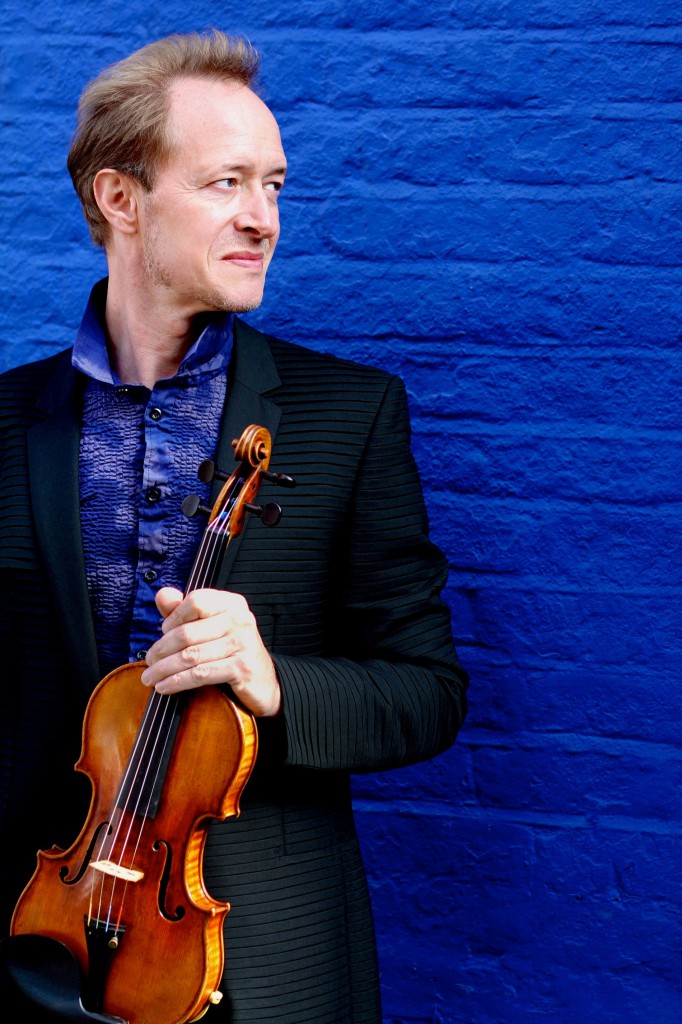New World opens chamber series with a wide-ranging mix

Anthony Marwood performed music of Chausson with New World Symphony members on Sunday. Photo: Walter van Dyck
The New World Symphony’s chamber season opened Sunday in Miami Beach with something for everyone.
There were two brief, enigmatic compositions by contemporary American composers, a lushly written classic of the Romantic period and an impeccably played, musically forgettable Baroque concerto.
The concert opened with Recovering, by the young American composer Christopher Cerrone.
Cerrone was one of several composers commissioned to write a response to Stravinsky’s ”L’Histoire du Soldat” (The Soldier’s Tale) for a 2012 concert in New York. As his point of inspiration, Cerrone chose a moment from the work’s “Pastoral,” developing his own piece for vibraphone based on a three-note Stravinsky motif.
With creative scoring, Cerrone achieved a sense of human breathing and pulse from supporting wind and brass players stationed on auxiliary stages around the hall, who blew tonelessly through their instruments.
Through this surrounding sound, the tones of the vibraphone reached upward, creating a sense of striving and expectation. Strident, faintly menacing trumpet and violin tones broke through, bringing the work to crises that resolved in a hard-won tranquility as the vibraphone pulse persisted. Well-crafted and cerebral, Recovering might have appealed to Stravinsky himself.
Best-known today for his “Devil’s Trill” sonata for violin and piano, the violinist and composer Giuseppe Tartini wrote a vast number of other works, many of which doubtless deserve to be heard more frequently. The Violin Concerto in B minor, performed Sunday, isn’t one of them.
The execution by the small orchestra was virtually flawless, with smooth, lean, agile playing in music that would expose any faults of intonation. The violin soloist, New World member Kevin Chen, played in a vigorous, authoritative manner, easily handling the runs, the cadenzas, the passages in two simultaneous notes and everything else, with a light, incisive tone that suited the period of its composition.
But the concerto wasn’t all that interesting, chugging along without much evidence of melodic or dramatic inspiration. There were tunes, there was virtuoso display, but there was little evidence of the man who composed such a gripping work as the “Devil’s Trill.”
The American composer Gabriela Lena Frank drew on her Peruvian ancestry for her Canto de Harawi: “Amadeoso” for flute, clarinet and piano. The title reflects her mixed musical and personal background. The Harawi is an Andean love song, and Amadeoso refers to her recurring childhood dream of walking hand-in-hand with Mozart.
This was an improvisatory, meditative work, making spare use of the modest forces on stage. The clarinet appeared to be a stand-in for the composer, often heard unaccompanied, as if portraying a person wandering alone. Clarinetist Jesse McCandless gave a searching, expressive of the part, with a rounded tone and sense of the dreamscape that the music was portraying.
British violinist Anthony Marwood served as guest soloist for Chausson’s Concerto in D major for Violin, Piano and String Quartet. For this odd hybrid of a piece, Marwood performed standing, next to pianist John Wilson and a string quartet of New World members.
Although virtually unblemished technically, the New World string players might have erred a bit in leaning toward the subdued side in music that is so rich in lush harmonies and textures. But their deference had the effect of highlighting the passionate playing of Marwood, whose throbbing vibrato and florid style brought off this sensuous music. At the piano, Wilson gave a fluid account of his busy part, with just enough percussive bite to add depth to the ensemble’s tone.
They performed the Grave movement in a manner that did full justice to its title. After Marwood’s extroverted playing in the other movements, his bleak, almost dead tone provided an effectively abrupt shift in mood. The members of the quartet matched him, ending with a pianissimo passage that was strikingly resonant and balanced. The last movement came as a burst of energy and high spirits, with Marwood’s honeyed tone topping the vigorous playing of the other musicians.
Posted in Performances
Leave a Comment
Mon Oct 15, 2018
at 11:33 am
No Comments




